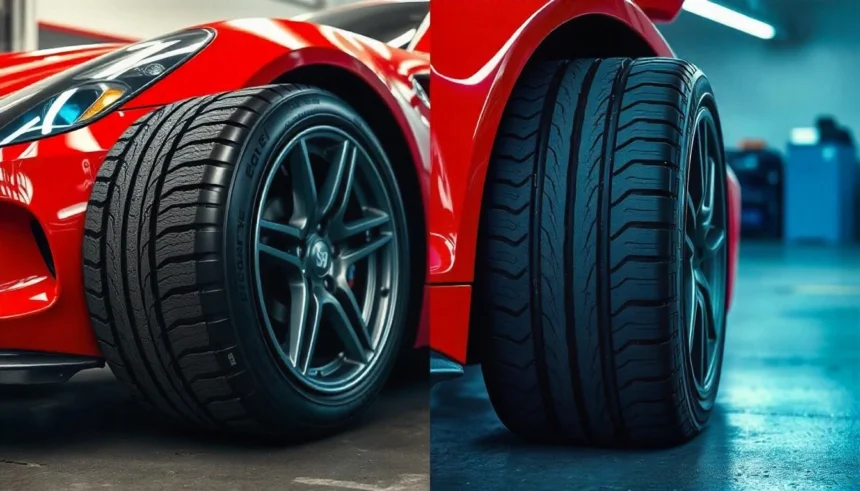Tire rotation is one of the most essential maintenance tasks for any vehicle owner. Regularly rotating your tires helps maintain even tread wear, improves vehicle performance, enhances fuel efficiency, and extends the lifespan of your tires. But how often should you rotate your tires? The answer depends on various factors, including the type of vehicle you drive, your driving habits, and road conditions. This comprehensive guide will provide expert insights into tire rotation intervals, factors that influence rotation frequency, and best practices to keep your tires in top shape.
What is Tire Rotation?
Tire rotation refers to the practice of moving each tire to a different position on the vehicle to ensure even tread wear. This process helps balance the wear patterns that naturally occur due to variations in weight distribution, braking, and steering.
Recommended Tire Rotation Intervals
The general recommendation for tire rotation is every 5,000 to 8,000 miles, which coincides with most oil change intervals. However, specific guidelines may vary based on the following:
- Manufacturer Recommendations: Always refer to your vehicle owner’s manual for precise rotation intervals. Some manufacturers recommend rotation every 7,500 miles, while others may suggest a shorter or longer interval.
- Type of Drivetrain: Different drivetrains affect how tires wear and, therefore, influence rotation frequency.
- Front-Wheel Drive (FWD): Front tires wear out faster due to steering and power transmission. Rotation every 5,000 to 7,500 miles is ideal.
- Rear-Wheel Drive (RWD): Rear tires experience more wear than the front. Rotate them every 5,000 to 7,500 miles.
- All-Wheel Drive (AWD) & 4-Wheel Drive (4WD): AWD and 4WD vehicles distribute power across all tires, but uneven wear can still occur. Rotation every 5,000 to 6,000 miles is recommended.
Factors That Affect How Often You Should Rotate Your Tires
While the standard intervals provide a general guideline, several factors influence how often you should rotate your tires:
1. Driving Habits
- Frequent hard braking, rapid acceleration, and aggressive cornering cause uneven tire wear.
- City driving with frequent stops and turns may require more frequent rotation than highway driving.
2. Road Conditions
- Rough roads, potholes, and unpaved surfaces contribute to faster tread wear.
- Driving in mountainous regions or areas with steep inclines puts extra stress on tires.
3. Tire Type and Quality
- Performance tires, all-terrain tires, and winter tires may have different wear patterns requiring customized rotation schedules.
- High-performance and soft compound tires wear out faster than standard all-season tires.
4. Vehicle Weight and Load
- Heavy vehicles, such as SUVs and trucks, put more strain on tires, making frequent rotations necessary.
- Carrying heavy loads regularly increases stress on specific tires, leading to uneven wear.
Benefits of Regular Tire Rotation
Proper tire rotation offers multiple benefits that contribute to vehicle performance and safety:
1. Extends Tire Lifespan
Uneven wear can cause premature tire replacement. Rotating tires ensures even wear, maximizing their lifespan and saving you money in the long run.
2. Improves Safety
Tires with uneven tread wear reduce traction, making it harder to control the vehicle, especially in wet or icy conditions. Regular rotation helps maintain optimal grip on the road.
3. Enhances Fuel Efficiency
Worn-out or unevenly worn tires increase rolling resistance, requiring more energy (fuel) to move the vehicle. Properly rotated tires improve fuel efficiency.
4. Provides a Smoother Ride
Uneven tread wear leads to vibrations and a rough ride. Regular rotations help maintain balanced handling and comfort.
Tire Rotation Patterns
The correct rotation pattern depends on your vehicle’s drivetrain and whether the tires are directional or non-directional.
1. Forward Cross (For FWD Vehicles)
- Front tires move to the rear.
- Rear tires move diagonally to the front.
2. Rearward Cross (For RWD Vehicles)
- Rear tires move to the front.
- Front tires move diagonally to the rear.
3. X-Pattern (For All Drivetrains)
- All tires are swapped diagonally.
4. Side-to-Side (For Directional Tires)
- Directional tires must remain on the same side of the vehicle and only be swapped front to back.
Common Mistakes to Avoid When Rotating Tires
1. Skipping Rotations
Delaying or skipping tire rotations leads to uneven wear, reducing tire lifespan and performance.
2. Using Incorrect Rotation Patterns
Following the wrong rotation pattern for your vehicle can cause irregular wear and affect handling.
3. Failing to Check Tire Pressure and Alignment
- Always check and adjust tire pressure after rotation.
- Wheel alignment should also be inspected to ensure smooth handling.
4. Ignoring Tire Condition
Check for signs of damage, such as cracks, bulges, or excessive wear, when rotating tires.
Frequently Asked Questions
1. Can I Rotate My Own Tires?
Yes, with the proper tools (jack, jack stands, and lug wrench), you can rotate your own tires. However, visiting a professional ensures correct rotation patterns and proper balancing.
2. What Happens If I Don’t Rotate My Tires?
Skipping rotations leads to uneven tread wear, reduced traction, poor handling, and the need for premature tire replacement.
3. Do New Tires Need Rotation?
Yes, even new tires require rotation to establish even wear patterns.
4. Does Tire Rotation Affect Wheel Alignment?
No, but improper alignment can cause uneven wear. Always check alignment if you notice abnormal wear patterns.
Final Thoughts
Rotating your tires at the recommended intervals is crucial for vehicle safety, performance, and cost savings. By following proper rotation practices and avoiding common mistakes, you can extend the life of your tires and ensure a smoother, safer ride. Always refer to your vehicle’s owner’s manual for specific recommendations, and consult a professional mechanic if you have any concerns about your tires.







